(Santa Barbara and Ventura counties)
Species / Location
Southern California supports two different forms of the native steelhead trout Oncorhynchus mykiss: rainbow trout, which live in freshwater for their entire lives as residents in streams, and steelhead, which are anadromous. An “anadromous” form hatches in freshwater, heads out to sea to mature to adulthood, and then returns to freshwater to spawn. In southern California, steelhead are listed as “endangered” under the Endangered Species Act.
Need for Drought Stressor Monitoring
The long drought is hitting southern steelhead hard, and the California Department of Fish and Wildlife (CDFW) is taking measures to conserve this sensitive species.
Stressor Monitoring Efforts
From spring through fall 2014, CDFW staff assessed drought and habitat conditions in four creeks in Santa Barbara and Ventura counties (Rattlesnake, Arroyo Hondo, Santa Paula, and North Fork Matilja creeks) that are known to provide spawning and rearing habitat for steelhead, and staff mapped habitat reduction (see Figures 1A and 1B, below). During the surveys, CDFW biologists collected GPS location points of wet and dry reaches of streams and assessed the extent that streams were drying.
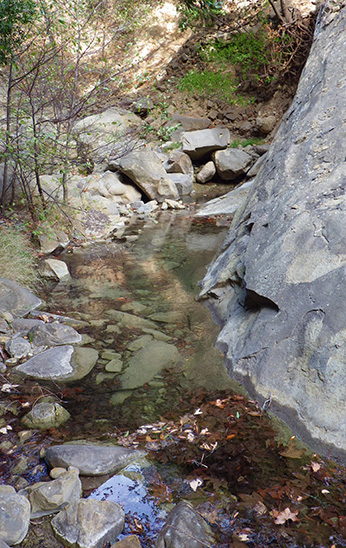 Figure 1A. Arroyo Hondo in April 2014. (CDFW photo)
Figure 1A. Arroyo Hondo in April 2014. (CDFW photo)
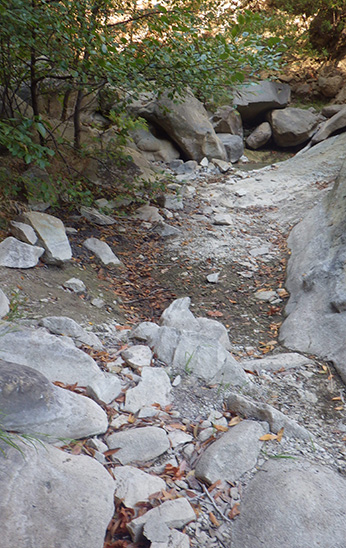 Figure 1B. Arroyo Hondo in September 2014. (CDFW photo)
Figure 1B. Arroyo Hondo in September 2014. (CDFW photo)
Findings
The maps below (Figures 2–5 A&B) compare habitat reduction of the four creeks. Rattlesnake Creek lost the most wetted habitat (almost 90% loss from spring to fall 2014) but all four creeks experienced significant drying. CDFW began assessing whether to conduct fish rescues from the drying reaches based on these results. Unfortunately, because of the limited amount of stream habitat available, it can be difficult to find release locations for rescued steelhead, and available habitat often cannot support any more fish, thus the benefits of rescue to the population can be unclear.
Knowing the locations of dry streambed reaches during this year’s drought helps CDFW to predict what will go dry in future droughts and assists us in identifying sensitive populations that may be at greater risk. Our work in assessing quantity of water during diminished flows has also provided insight as to the degraded water quality conditions faced by steelhead during reduced flows. With the information collected in this study, CDFW can be more effective at prioritizing restoration to ensure that steelhead have access to reaches of refuge that are last to dry during times of drought.
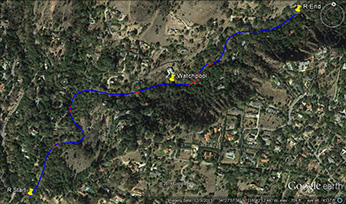 Figure 2A. Rattlesnake Creek, Santa Barbara County, in April 2014 and in The blue lines indicate wetted stretches . The surveyed stretch had an 87.9% reduction in wetted length between April 2014 and October 2014. (click/tap to enlarge)
Figure 2A. Rattlesnake Creek, Santa Barbara County, in April 2014 and in The blue lines indicate wetted stretches . The surveyed stretch had an 87.9% reduction in wetted length between April 2014 and October 2014. (click/tap to enlarge)
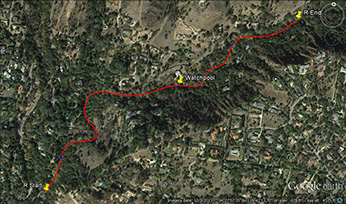
Figure 2B. Rattlesnake Creek, Santa Barbara County, in October 2014. The red lines indicate dry stretches. The surveyed stretch had an 87.9% reduction in wetted length between April 2014 and October 2014. (click/tap to enlarge)
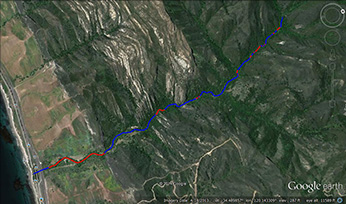 Figure 3A. Arroyo Hondo Creek, Santa Barbara County, in February 2014 . The blue lines indicate wetted stretches. The surveyed stretch had a 26% reduction in wetted length between February 2014 and September 2014. (click/tap to enlarge)
Figure 3A. Arroyo Hondo Creek, Santa Barbara County, in February 2014 . The blue lines indicate wetted stretches. The surveyed stretch had a 26% reduction in wetted length between February 2014 and September 2014. (click/tap to enlarge)
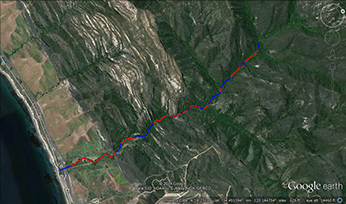 Figure 3B. Arroyo Hondo Creek, Santa Barbara County, in September 2014. The red lines indicate dry stretches. The surveyed stretch had a 26% reduction in wetted length between February 2014 and September 2014. (click/tap to enlarge)
Figure 3B. Arroyo Hondo Creek, Santa Barbara County, in September 2014. The red lines indicate dry stretches. The surveyed stretch had a 26% reduction in wetted length between February 2014 and September 2014. (click/tap to enlarge)
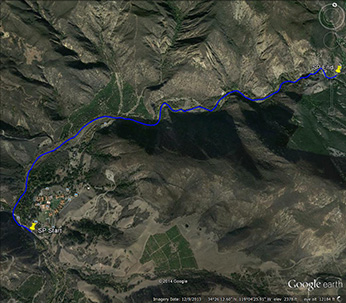 Figure 4A. Santa Paula Creek, Ventura County, in May 2014. The blue lines indicate wetted stretches . The surveyed stretch had a 22.1% reduction in wetted length between May 2014 and October 2014. (click/tap to enlarge)
Figure 4A. Santa Paula Creek, Ventura County, in May 2014. The blue lines indicate wetted stretches . The surveyed stretch had a 22.1% reduction in wetted length between May 2014 and October 2014. (click/tap to enlarge)
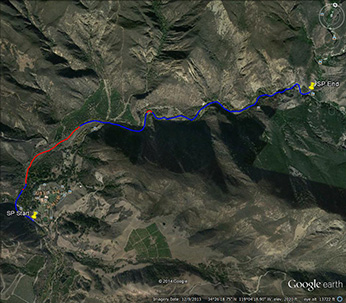 Figure 4B. Santa Paula Creek, Ventura County, in October 2014. The red lines indicate dry stretches. The surveyed stretch had a 22.1% reduction in wetted length between May 2014 and October 2014. (click/tap to enlarge)
Figure 4B. Santa Paula Creek, Ventura County, in October 2014. The red lines indicate dry stretches. The surveyed stretch had a 22.1% reduction in wetted length between May 2014 and October 2014. (click/tap to enlarge)
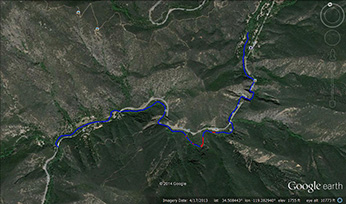 Figure 5A. North Fork Matilija Creek, Ventura County, in October 2013. The blue lines indicate wetted stretches . The surveyed stretch had a 9.4% reduction in wetted length between October 2013 and October 2014. (click/tap to enlarge)
Figure 5A. North Fork Matilija Creek, Ventura County, in October 2013. The blue lines indicate wetted stretches . The surveyed stretch had a 9.4% reduction in wetted length between October 2013 and October 2014. (click/tap to enlarge)
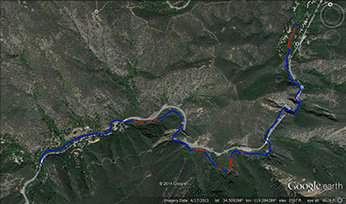 Figure 5B. North Fork Matilija Creek, Ventura County, in October 2014. The red lines indicate dry stretches. The surveyed stretch had a 9.4% reduction in wetted length between October 2013 and October 2014. (click/tap to enlarge)
Figure 5B. North Fork Matilija Creek, Ventura County, in October 2014. The red lines indicate dry stretches. The surveyed stretch had a 9.4% reduction in wetted length between October 2013 and October 2014. (click/tap to enlarge)
Future Efforts
As the drought conditions persist, CDFW plans to continue to monitor these four streams and possibly more as allowed by funding and staffing. We hope that the winter of 2014-2015 will bring much needed rains and relief to these populations of southern steelhead.
CDFW